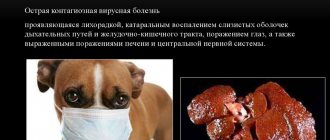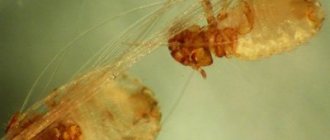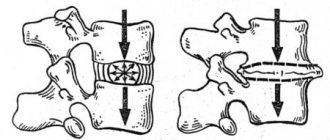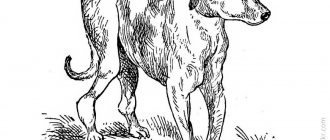Heartworms in dogs are nematodes (roundworms), the adults of which are found in the pulmonary artery and right chambers of the dog’s heart.
There are two types of such helminths:
What to do in such a situation? To get started, we recommend reading this article. This article describes in detail methods of controlling parasites. We also recommend that you consult a specialist. Read the article >>>
Dirofilaria immitis or heartworms (eng. Heartworm) is a species that belongs to filariae (thread-like worms), or more precisely, dirofilariae. These are the best known parasites that attack the dog's heart, causing heartworm . They are transmitted through mosquito bites and can also infect humans, cats, ferrets, reptiles and some other animals.
Angiostrongylus vasorum or French heartworms are helminths that can primarily infect foxes and dogs, causing the disease canine angistrongylosis (angiostrongylidosis).
They are also classified as pulmonary nematodes, since when they reproduce, the larvae pass through the lungs, damaging them. Transmitted through intermediate hosts such as slugs, snails, frogs, or through food contaminated with mucus from an infected snail. Not dangerous for humans.
Description of pathogens
The length of adult female heartworms (D. immitis), which infects a dog’s heart, reaches 30 cm, males are slightly shorter. Worms can live in an animal’s body for up to 2 years, before which it takes about 6 months for them to fully develop.
These parasites also pose a danger to humans, but they do not survive in his body, but are encapsulated in the lungs and die. As a result, granulomas (inflammatory formations) appear, which in the pictures can be confused with lung cancer.
Angiostrongylus vasorum is much smaller - up to 2 cm in length. These are small pinkish worms. Adults can live for 2 years. It takes 6-10 weeks for them to develop in the dog’s body and reach their permanent habitat. They are not dangerous for people.
Depending on the pathogen, the routes of infection are very different, as is the development cycle of the parasites.
Danger to humans
The human body is not a suitable place for heartworms to reproduce. The larvae do not leave the subcutaneous tissue. However, they can develop into a sexually mature individual. In the absence of a sexual partner, the reproductive cycle is interrupted. The helminth stays under the skin or in the eye for 7–8 months and can be disturbing, moving, causing itching and inflammation.
Heartworm
Dirofilaria immitis
Heartworms (D. immitis) can be transmitted through the bites of more than 70 species of mosquitoes. The insect bites the infected animal and, along with the blood, captures the larvae (microfilariae) floating there. After this, the mosquito plays the role of an intermediate host, in which the larvae develop (molt twice) from about 8 days to a month, depending on the ambient temperature.
If it is below 14 °C, then the parasite freezes and waits for warmth. This means that where there are seasonal climate changes, transmission of these heartworms to a dog or other animal may only occur during the warmer months.
Dirofilaria immitis and Dirofilaria repens
After a mosquito bite, the larvae end up in the subcutaneous tissues of the dog, where they develop. Within 2-3 months they reach a young adult form. Then they enter the pulmonary artery through the bloodstream, and in large quantities, into the heart. As a result, the period between a mosquito bite and the appearance of fully adult worms in the heart is 6-7 months.
Angiostrongylus vasorum
A. vasorum (French heartworm) larvae are passed in the feces of a sick animal. They are consumed by intermediate hosts - mollusks (snails and slugs), within which two molts take place. The slugs can then be swallowed by the frog and become a transport (paratenic) host.
Dogs most often become infected with these heartworms by ingesting shellfish containing the larva. Infection is also possible by eating a frog or food that has been exposed to snail mucus along with the larva.
Inside the dog, the larvae migrate to the mesenteric lymph nodes, where they moult twice into a young adult form and travel to the pulmonary vein and right chambers of the heart, where they finally grow and begin to reproduce.
Angiostrongylus vasorum
This takes 6-10 weeks. Viviparous females immediately produce larvae, which are coughed up by the dog, swallowed and passed in the feces.
Such parasites can live in the body of any animal or person, but reproduction occurs only in various internal organs of dogs of any age and breed.
Prevalence
Dirofilaria immitis
The disease used to be common mainly in the southern part of the United States. But now it is found almost anywhere there are mosquitoes that can spread these heartworms, even in Alaska. Therefore, dirofilariasis is also common in Australia, Southern Europe, the Middle East, Southeast Asia, and Japan. Cases of infection have been recorded in 50 countries.
Angiostrongylus vasorum
These canine heartworms don't cover many regions. This is mainly Western Europe, especially the UK, Ireland, France and Spain. Also known habitats of French heartworms include Uganda in Africa, Turkey and the countries of the former USSR in Asia, and North America. The geography of the parasite is constantly expanding. The fox is hypothesized to be an important reservoir for this parasite based on the observed relationship between the rate of affected dogs and the presence of foxes in the region.
Development of the disease
Dirofilariasis is a very life-threatening disease for dogs. This is due to the fact that parasites are most often localized in the heart of dogs (in the right atrium), less often in the muscles, eyes and blood vessels. In these organs they reproduce and feed.
The greatest chance of becoming infected with dirofilariasis is in late summer and early autumn. It is transmitted from one sick dog to another through mosquito bites. According to statistics, breeds with smooth coats are more susceptible to this parasitic disease.
The initial stage of development of parasites is associated with the appearance of larvae - microfilariae. They can remain in the animal’s circulatory system for up to several years. A mosquito becomes a carrier of parasites after biting an infected dog. During a bite, the larvae enter the digestive system along with the blood. During a new bite from a healthy animal, the larvae penetrate through the skin and cells.
Under the skin, parasites continue to develop for many months. Then they move to the vessels and penetrate the heart. After 7–8 months of staying inside the body, the parasites begin to multiply. Their life expectancy is 2–3 years. The length of heartworms can reach 30 cm. In shape, they resemble thin long threads of light yellow color.
The danger for the dog is not the vital activity of the parasites itself, but their death. After death, the body of helminths breaks up into many parts. They begin to clog the lumen of capillaries and blood vessels. In this case, dirofilariasis in dogs is often fatal.
How is heart dirofilariasis spread?
The disease does not spread directly from dog to dog.
Because transmission of the disease requires a mosquito as an intermediate host, the disease cannot be transmitted directly from dog to dog. Consequently, the spread of the disease occurs during the mosquito season, which in some regions can last year-round. The number of infected dogs and the length of the mosquito season directly correlate with the incidence of heartworm disease in any region.
The mosquito usually bites the dog in those places where the coat is thinnest. However, having long hair cannot prevent infection.
Main signs of the disease
First of all, the cardiac and vascular system suffers. Most often, worms are localized in the right atrium or pulmonary artery.
By intertwining with each other, they prevent blood from reaching the heart muscle. As a result, heartworms in dogs lead to the development of a whole range of symptoms.
- Insufficient oxygen supply along with the blood leads to cardiac dysfunction. There is swelling of the limbs and lower jaw.
- Worms in the heart lead to a decrease in hemoglobin. Symptoms of anemia appear. The dog looks tired, apathetic, sleeps a lot, and gets tired quickly.
- The integrity of blood vessels is compromised.
- Insufficient blood supply to the kidneys and liver leads to disruptions in the functioning of these organs.
Heart worms in dogs can be accompanied by symptoms of damage to the respiratory system.
- Shortness of breath appears.
- The dog has difficulty breathing.
- I am worried about a dry cough, the intensity of which increases over time.
- If the lungs are affected, the cough may contain phlegm. Another characteristic sign is the presence of streaks of blood in the sputum.
- The veterinarian may listen for wheezing in the lungs.
- Body heat, cramps.
Against the background of all these symptoms, other specific signs of the disease may appear:
- sudden loss of body weight;
- there is poor appetite;
- The pet itches frequently and severely, and hair falls out.
Symptoms and their intensity depend on how long the parasites have been living in the dog’s body and how much destruction of internal organs has occurred.
Forecast
The favorable prognosis directly depends on timely initiation of therapy. If the number of worms is small and there are no secondary serious damage to the internal organs, the pet’s future life is not in danger.
Otherwise, when there is a large accumulation of parasites, therapeutic deworming poses a great threat to life. The decay products of dead worms not only cause severe intoxication of the entire body, but are also capable of blocking blood flow in large blood vessels. This factor leads to the death of the animal.
Confirmation of diagnosis in the laboratory
If at least one warning sign appears, your pet should be shown to a veterinarian. Timely diagnosis of the disease can protect the dog from severe consequences associated with damage to the heart and lungs.
- The most accurate method for diagnosing heartworm disease in dogs is a rapid test for the presence of antigens of adult female heartworms. The result becomes known within 10 minutes. Blood tests are also used to determine the effectiveness of treatment for a disease.
- An immunological blood test allows you to determine the amount of antibodies produced by the body in response to parasites.
- An ECG helps detect changes in the heart muscle and determine its rhythm.
- The examination should include echocardiography. Results may show pulmonary hypertension, right ventricular changes.
- A chest x-ray may show changes in the size of the pulmonary arteries, as well as enlargement of the right ventricle and atrium.
A false negative laboratory test result may be due to a small number of parasites, a predominance of male parasites, or the rapid development of helminths, as a result of which they quickly penetrate the pulmonary arteries.
Symptoms of Heartworm Infection in Dogs
At the first stage, heartworm disease in dogs is very difficult to diagnose because its symptoms are characteristic of many other heart and lung diseases. The presence of signs is directly related to the age of the dog, the number of worms and physical activity. Sometimes there are no symptoms of heartworm infection in dogs or only a cough.
Stages of infection with heartworm Dirofilaria immitis
- Six months after your dog is infected with heartworms, your dog develops a slight cough. This is caused by the fact that parasites have entered the dog's lungs, interfering with normal breathing, causing inflammation and an allergic reaction.
- Increased cough, wheezing, kidney and liver failure, lethargy and decreased appetite. Vomiting with blood clots often occurs.
- General deterioration of the dog's condition, stiffness of movements, severe enlargement of the dog's chest when breathing.
- Arrhythmia and difficulties in the blood supply to tissues and organs due to the blocking of blood vessels by worms and their accumulation in the cardiac regions. At this stage of the disease, only urgent surgical intervention can help.
Stages of infection with heartworm Angiostrongylus vasorum
The most common stages of a dog becoming infected with Angiostrongylus vasorum heartworms include coughing, shortness of breath, poor blood clotting, and collapse.
Diagnosis of cardiac nematodes
In the initial stages of dirofilariasis infection, diagnosing the disease becomes very difficult. Clinical manifestations of the pathology are similar to diseases of the respiratory tract and cardiovascular system. When diagnosing heartworms, it is necessary to conduct comprehensive examinations of the animal.
Making an accurate diagnosis for the presence of worms in the heart of dogs involves collecting the pet’s medical history, as well as a thorough examination of the animal. It is advisable to use radiographic and ultrasound examinations.
Electrocardiography is often performed in a veterinary hospital to differentiate pathology from other diseases with similar symptoms.
This type of diagnosis makes it possible to determine hypertension in the lungs of a chronic nature, the development of which increases vascular resistance (provoking right-sided myocardial failure).
An accurate diagnosis of cardionematodosis includes a biochemical blood test. Also taken into account are the results obtained after the use of special test systems that help determine the presence of microfilariae in the pet’s bloodstream.
Treatment of the disease
If heartworms are detected in the dog's blood, the following medications may be prescribed.
- Arsenamide is an arsenic drug that is active only against adults. The solution is administered intravenously at 0.001 g per 1 kg of dog’s body weight. The course of treatment is two weeks.
- Diethelcarbamazine (Carbilazine, Ditrazine, Dicacid). The drug is effective against larvae. It is less active against adults. The dosage is calculated at 0.025 g per 1 kg of animal body weight, which is administered three times a day for three weeks. For preventive purposes in the summer, during the period of mosquito activity, the dosage is maintained, but the duration of treatment is reduced to 7 days. The course can be repeated every two months.
- Levamisole. This drug effectively treats dirofilariasis at the initial stage of development. Prescribe 0.01 g per 1 kg of dog weight. Kills larvae and female adult heartworms. The effect of the medicine does not apply to their males.
- Filarsen (Dichlorphenarsine, Halarsol). Only affects adults. Give to the animal three times a day at a dosage of 0.01 g per 1 kg of body weight. The duration of treatment is 10 days.
- In dogs, treatment is often carried out using the drug Immiticide. It is administered intramuscularly (in the area of the lumbar muscle). The dosage is 2.5 mg per 1 kg of dog’s body weight. Two injections with an interval of 24 hours are enough.
In addition to anthelmintic drugs, treatment of dirofilariasis in dogs is accompanied by the use of other medications: medications that restore the activity of the cardiac and circulatory system, immunomodulators, antihistamines, hepatoprotectors, enterosorbents.
If you have to undergo treatment at home, you need to follow some rules. During treatment, the dog should be kept away from activity. It's better to put her in a cage. Walks should be limited to 5-10 minutes and only on a leash. She can return to full physical activity 6 months after the start of the treatment course.
A complication of treatment is pulmonary embolism as a result of mass death of parasites.
If treatment does not respond to conservative treatment, surgery is prescribed. During the operation, worms are removed from the atrium. Thus, the number of adults capable of reproduction decreases.
In the future, treatment is continued with anthelmintic drugs. Symptoms gradually decrease in intensity and recovery occurs.
Preliminary treatment
Before prescribing an anti-dirofilariasis drug, it is necessary to find out whether the pet has diseases for which such treatment is contraindicated. If heartworms are detected by radiographic or echocardiographic methods, cardiac and pulmonary pathologies must be eliminated before administering adulticide. Further treatment is the same as for a low degree of infestation.
Adjuvant therapy
Mandatory for all treatment methods. Corticosteroids are used, which have an anti-inflammatory effect, as well as heparin, which prevents blood clots.
Surgical treatment
To save a pet in the event of a severe venous circulation disorder, the veterinarian has no more than 48 hours. Before and after the operation, auxiliary treatment is carried out.
Helminths are extracted from the atrium and vena cava. The alternative method of removing parasites from the pulmonary arteries is difficult and dangerous. After the operation, adulticide is administered.
Prevention
You can avoid heartworm infection by following a number of rules. Owners of dogs located in regions unfavorable for helminthiasis should be especially attentive to the prevention of dirofilariasis.
It is important to carry out routine deworming of dogs in a timely manner, especially in the period before the onset of mosquito activity.
Before traveling out of town, it is important to treat your pet’s fur with special repellents and products to prevent mosquito and sandfly bites. Routine diagnostics of your dog's health once a year will also help avoid possible heartworm infection.
At the first characteristic symptoms of your pet’s ill health, you need to seek help from a veterinary hospital. Treatment of heartworms is most appropriate in the early stages of the disease and the prognosis will be favorable.
It is possible to defeat parasites!
Antiparasitic Complex® - Reliable and safe removal of parasites in 21 days!
- The composition includes only natural ingredients;
- Does not cause side effects;
- Absolutely safe;
- Protects the liver, heart, lungs, stomach, skin from parasites;
- Removes waste products of parasites from the body.
- Effectively destroys most types of helminths in 21 days.
There is now a preferential program for free packaging. Read expert opinion.
Read further:
Long worms in dogs: main types, description and methods of treating parasites in dogs
What to give your dog for worms, review of the best anthelmintics
Alben anti-worm tablets for cats, dogs and other animals: instructions for use
Azinox against worms for cats and dogs: instructions for use, reviews
Dirofen against worms for cats and dogs: instructions for use, price, analogues
Milbemax against worms for cats and dogs: instructions for use, cost, reviews











